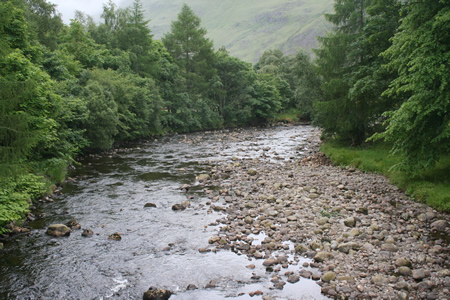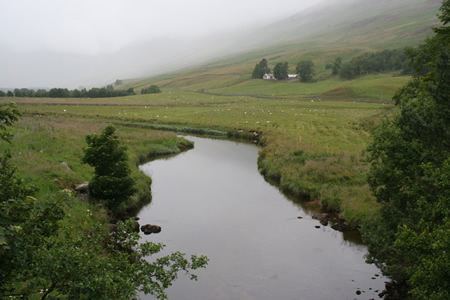These bulletin blogs represent news about Finavon and the South Esk, and my views as a riparian owner. They are not the views of any other organisation, nor are they designed to promote the interests of any individual or organisation other than Finavon Castle Water and factors affecting the fishery. Tony Andrews
A peaty and warm river doesn’t do much for salmon fishing. And so it proved in the last days of the 2011 season. Comparing notes with Inshewan, Colin Gibb and I agreed that the 2011 season was good in parts and lacklustre in others – a curate’s egg of a season. Finavon ended up with 139 salmon and grilse and Inshewan with 153 with MSW salmon dominant and grilse in short supply (although, interestingly, I have seen a number of fresh grilse running in the last three days). The two fisheries each caught 101 sea trout, which is about one third of the totals we expected in the 1990s. We agreed that the Spring salmon fishing up to 31st May was as good as we can remember. We speculated that, had the Kinnaird Dyke been as it was in the 1970s, the Upper Kinnaird catch would have been in the hundreds in the spring. Fortunately, as a result of improvements to the dyke, salmon can now spread throughout the catchment, with a resulting exploitation rate of about 15% of what it was when fish were trapped in the pools immediately downstream of the Dyke.
The slow end to the season will not have been helped by alleged unauthorised digging out of peat channels in Glen Clova, which released huge quantities of peat in suspension that removed oxygen from the water and sickened the fish, making them reluctant to take a fly. In these days of Controlled Activities Regulations, and with SEPA the watchdog for breaches of the law, one can only hope that the person that may have authorised this hugely damaging work receives a whacking great fine. Farmers must obey the law, just as the rest of us have to. If farmers continue do do as they like in the catchment, we will have made no progress and our Board and Trust, if they fail to take action, will be conniving with an illegal act. There’s work to be done.
This is the Upper South Esk catchment in Glen Clova where farmers have done untold damage in recent years. First the Rottal Burn’s lower reaches were dredged into a straight canal gravel flush, effectively wiping out juvenile habitat, and in the last few months more damage has been done by unauthorised digging out of peat drains. Every time an illegal excavation is done it sets back habitat conservation by years. Prosecutions must follow.
Reverberations continue from last week’s public meeting, following the Minister’s decision to consider a licence for mixed stocks netting in September. An injudicious press release issued by our Board served only to elicit a furious and humiliating reaction from George Pullar which emphasises the need for reconciliation and dialogue however unfair or illogical we may feel the Minster’s decision to be. We now have a once in a generation opportunity to work with the government for the benefit of the River and to set aside the negative aspects of our dysfunctional relationships within the District.
These meanders of the River in Glen Clova are the places where the river spreads out and inundates the flood meadows in a spate. Farmers have traditionally dug out drains to dry out the land for grazing, but any intereference with natural water courses in this way is now illegal. Nevertheless, farmers still do it. Prosecutions and heavy fines are long overdue. If we fail to enforce the law (CARs) we may as well say goodbye to the benefits of the Water Framework Directive.
The priority within the Esk District must be to repair these relationships, re-establish goodwill and dialogue, and then move forward with an integrated plan for the river, including technical aspects of conservation and fishery management (the two should go hand-in-hand). In the list of priorities for management actions the really vital issue is to develop an effective and reliable methodology for counting the fish into and out of the River. I have said before in these blogs that management by speculation and guessing is not modern fishery management. With the massive commitments to the South Esk from the EU, SEPA, SNH, and the Scottish Government it would be very odd indeed if our own Board were not to come into line with these bodies and lend their support to a concerted action plan for the River. The Board needs to find about £250,000 of its own money (our money!) to invest in measuring stocks. This is not something that can be put on the backburner: it must be done soon, with the full cooperation of Marine Scotland. If we don’t do this now we will have missed a unique opportunity and our successors will not forgive us.
TA

